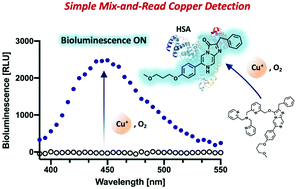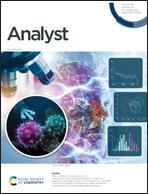Mix-and-read bioluminescent copper detection platform using a caged coelenterazine analogue†
Abstract
Serum copper levels are biomarkers for copper-related diseases. Quantification of levels of free copper (not bound to proteins) in serum is important for diagnosing Wilson's disease, in which the free copper concentration is elevated. Bioluminescence is commonly used in point-of-care diagnostics, but these assays require genetically engineered luciferase. Here, we developed a luciferase-independent copper detection platform. A luminogenic caged coelenterazine analogue (TPA-H1) was designed and synthesized to detect copper ions in human serum. TPA-H1 was developed by introducing a tris[(2-pyridyl)-methyl]amine (TPA) ligand, which is a Cu+ cleavable caging group, to the carbonyl group at the C-3 position of the imidazopyrazinone scaffold. The luciferin, named HuLumino1, is the product of the cleavage reaction of TPA-H1 with a copper ion and displays “turn-on” bioluminescence signals specifically with human serum albumin, which can be used to quantitatively analyse copper ions. TPA-H1 exhibited a fast cleavage of the protective group, high specificity, and high sensitivity for copper over other metal ions. This novel caged coelenterazine derivative, TPA-H1, can detect free copper ions in serum in a simple “mix-and-read” manner.



 Please wait while we load your content...
Please wait while we load your content...
